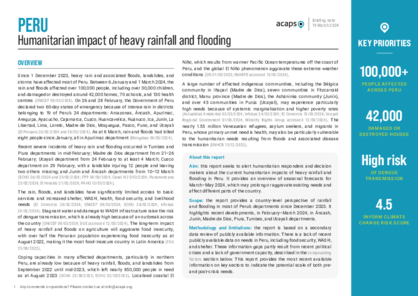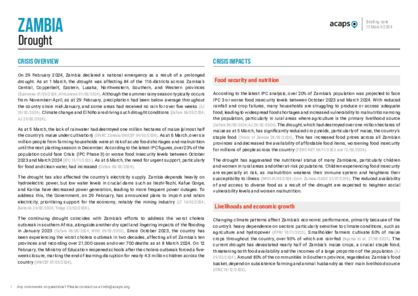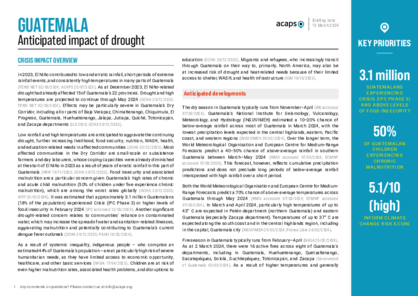HUMANITARIAN IMPACT OF EL NIÑO IN 2024
El Niño is expected to continue at least until April 2024.
El Niño-induced temperature and precipitation anomalies will continue during the first semester of 2024 in Central and South America (dry/wet conditions), East Africa (wet conditions), southern Africa (dry conditions), and Asia and the Pacific (dry/wet conditions).
Increasing humanitarian needs
Between January and June 2024, several countries already facing humanitarian crises may experience heatwaves, wildfires, floods, droughts, and epidemics due to El Niño.
El Niño is likely to increase humanitarian needs of the exposed populations, with food security and health expected to be the most affected sectors.
Climate change has the potential to amplify Niño-induced rainfall and temperature anomalies, triggering unpredictable and potentially more extreme outcomes.
JANUARY- JUNE 2024
RISK OF HUMANITARIAN IMPACTS FROM EL NIÑO
Disclaimer: Timor Leste and Vanuatu are not visible on this map. For more detailed information, please access the report.
What does ENSO stand for?
ENSO stands for El Niño and Southern Oscillation, a periodic fluctuation in sea surface temperature and changes in the air pressure across the equatorial Pacific Ocean.
ENSO is one of the main drivers of interannual climate variability. The two extreme ENSO phases are El Niño and La Niña. El Niño occurs when the surface waters in the central and eastern Pacific Ocean become warmer than average, and La Niña occurs when these waters become cooler than average. These changes in sea-surface temperatures can cause shifts in atmospheric pressure and winds, leading to changes in rainfall patterns, temperature, and other weather-related phenomena worldwide.
Climate change can amplify the rainfall variability related to ENSO and increase the likelihood of extreme weather events. Global warming is also increasing ENSO ‘variability’, and strong El Niño and La Niña events have occurred more frequently than the pre-1960 average. More frequent swings from a strong El Niño to a strong La Niña are anticipated in the future.
GLOBAL HUMANITARIAN IMPACTS OF EL NIÑO
Click on this interactive diagram to explore the rainfall and temperature anomalies, the associated hazards, and the main humanitarian impact dimensions of El Niño.
How does ACAPS assess the risk of El Niño impact?
The assigned risk level of El Niño impact is based on expert judgement following an assessment per country of the indicators/factors listed on the right:
Historical impact of previous El Niño events in the country
Typical influence of El Niño between January and June in the country
Seasonal precipitation and temperature forecast for the first semester of 2024
Impact of El Niño in 2023 in the country and materialisation of seasonal forecasts/alerts
Pre-existing humanitarian crises and vulnerabilities to El Niño-related hazards
Agricultural seasonality
National/local response capacity to natural hazards/impact from natural hazards
Expected impact on agriculture, livestock, and fishery
Potential spill-over effects of El Niño on local food prices and the economy
Potential disease outbreaks and increased health needs
Analysis products
on
Global climate analysis
25 March 2024
Bolivia: Flooding and landslides in Beni, La Paz, and Pando departments
DOCUMENT / PDF / 975 KB
Since November 2023, Bolivia has been experiencing above-average rainfall, particularly in February 2024, resulting in floods and landslides. As at 18 March, floods and landslides had affected over 150,000 people.
19 March 2024
Peru: Humanitarian impact of heavy rainfall and flooding
DOCUMENT / PDF / 708 KB
This report seeks to alert humanitarian respoIt provides an overview of seasonal forecasts for March–May 2024, which may prolong or aggravate existing needs and affect different parts of the country.nders and decision makers about the current humanitarian impacts of heavy rainfall and flooding in Peru.
15 March 2024
Zambia: impact of drought
DOCUMENT / PDF / 509 KB
On 29 February 2024, Zambia declared a national emergency as a result of a prolonged drought. As at 1 March, the drought was affecting 84 of the 116 districts across Zambia’s Central, Copperbelt, Eastern, Lusaka, Northwestern, Southern, and Western provinces. Climate change and El Niño are driving such drought conditions.
13 March 2024
Guatemala: anticipated impact of drought
DOCUMENT / PDF / 401 KB
As at December 2023, El Niño-related drought had already affected 15 of Guatemala’s 22 provinces. Drought and high temperatures are projected to continue through May 2024. Effects may be particularly severe in Guatemala’s Dry Corridor.






